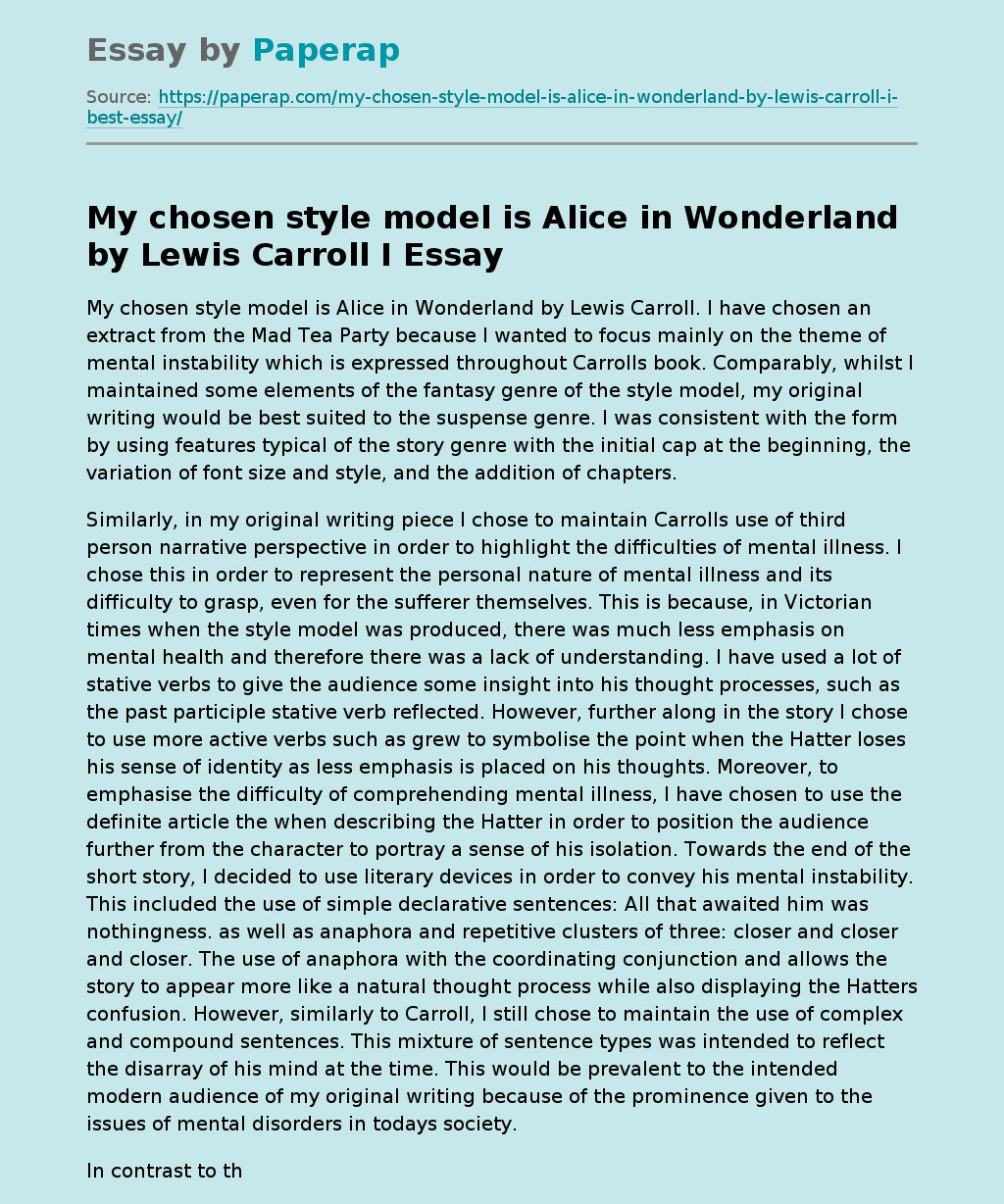"Alice in Wonderland" by Lewis Carroll
My chosen style model is Alice in Wonderland by Lewis Carroll. I have chosen an extract from the Mad Tea Party because I wanted to focus mainly on the theme of mental instability which is expressed throughout Carrolls book. Comparably, whilst I maintained some elements of the fantasy genre of the style model, my original writing would be best suited to the suspense genre. I was consistent with the form by using features typical of the story genre with the initial cap at the beginning, the variation of font size and style, and the addition of chapters.
Similarly, in my original writing piece I chose to maintain Carrolls use of third person narrative perspective in order to highlight the difficulties of mental illness. I chose this in order to represent the personal nature of mental illness and its difficulty to grasp, even for the sufferer themselves. This is because, in Victorian times when the style model was produced, there was much less emphasis on mental health and therefore there was a lack of understanding.
I have used a lot of stative verbs to give the audience some insight into his thought processes, such as the past participle stative verb reflected.
However, further along in the story I chose to use more active verbs such as grew to symbolise the point when the Hatter loses his sense of identity as less emphasis is placed on his thoughts. Moreover, to emphasise the difficulty of comprehending mental illness, I have chosen to use the definite article the when describing the Hatter in order to position the audience further from the character to portray a sense of his isolation.
Towards the end of the short story, I decided to use literary devices in order to convey his mental instability. This included the use of simple declarative sentences: All that awaited him was nothingness. as well as anaphora and repetitive clusters of three: closer and closer and closer. The use of anaphora with the coordinating conjunction and allows the story to appear more like a natural thought process while also displaying the Hatters confusion. However, similarly to Carroll, I still chose to maintain the use of complex and compound sentences. This mixture of sentence types was intended to reflect the disarray of his mind at the time. This would be prevalent to the intended modern audience of my original writing because of the prominence given to the issues of mental disorders in todays society.
In contrast to the style model, I chose to write from the perspective of the Hatter because, in Victorian times, it was common for hatters to use mercury during their work and prolonged exposure to the vapours could lead to mercury poisoning. Erratic and flamboyant behaviour was one of the most evident alterations caused by mercury which is why I chose to retain Carrolls eccentric writing approach. In order to achieve this, I have used techniques such as the capitalisation of the abstract noun Time in order to make it a proper noun.
Additionally, similarly to Carroll, I refer to time with the 3rd person personal pronoun he; he must have gotten away from me. As well as that, I have applied Carrolls technique of capitalising words for emphasis, such as the word MAD in the queens speech. Also, the Hatters frequent use of exclamatives has been extrapolated from the style model to my extract: Oh dear! I have used these often within the Hatters dialogue in order to express his erratic and anxious behaviour which would be considered abnormal in strict Victorian society, but are genuine symptoms of mental illness, more widely accepted in todays more open community. In order to emphasise his importance in my original writing, I sought to emulate Carrolls use of Hatter as a proper noun by using the capitalisation of the initial letter.
I have included a lot of dialogue to replicate the form of the style model: You have murdered time! I believe that this makes the story come to life for the audience, which is important for my original writing because of the style of Carroll which I have replicated, involving the use of imagination and the fabrication of reality. Similarly, I have also used Carrolls choice of repetition frequently throughout my story in order to reflect the monotony of his life after he is cursed by Time. Today is the day! Today is the day! Moreover, I have retained Carrolls use of humour and wit with the twist of the classic nursery rhyme which I included. This includes the use of rhyming couplets, similarly to Carrolls version in the style model.
To reflect the genre of my original writing I used humour, adding to the light-hearted feel, while a suspenseful tone is also continued with the use of short paragraphs: Tick tock. Tick tock. This creates a crisis for the Hatter and the ultimate heightened situation, where all he can hear is time passing him by. This represents the dynamic genre of my original writing as it initially felt part of the fantasy genre, similarly to the style model, but would now be best suited to the suspense genre. This change in tone was used to depict another mental illness which is bipolar disorder, characterised by sudden shifts in mood.
Overall, my original writing piece adopts a range of linguistic devices similar to those used by Lewis Carroll throughout the style model in order to convey my chosen theme of mental illness through the perspective of the character whom I chose to focus on, the Hatter.
"Alice in Wonderland" by Lewis Carroll. (2019, Dec 12). Retrieved from https://paperap.com/my-chosen-style-model-is-alice-in-wonderland-by-lewis-carroll-i-best-essay/

